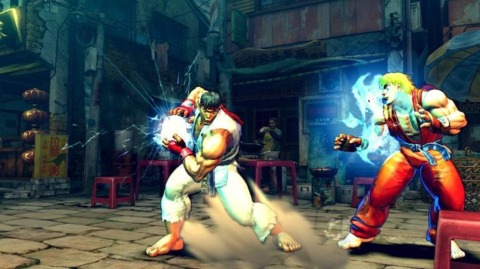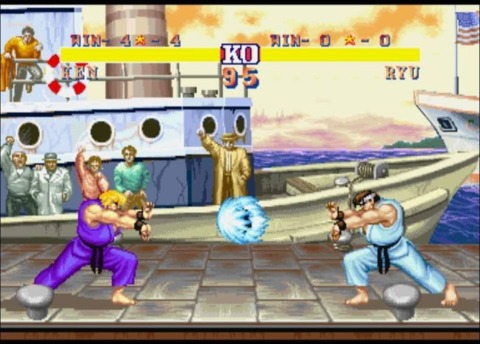GDC 2009: Street Fighter IV producer talks classic revamp
Capcom's Yoshinori Ono discusses resurrecting a genre-defining franchise while living up to a decade's worth of hype.
SAN FRANCISCO--More than a decade passed between the arcade release of Street Fighter III and February's debut of Street Fighter IV. Over that span, the 2D fighting genre that the Street Fighter franchise defined in the '90s fell by the wayside, a niche within a niche kept alive by a handful of companies. So when Capcom announced that it was returning to the Street Fighter franchise for a fourth full installment--and that the series would jump into the world of 3D--there was an understandable amount of concern among fans.

Street Fighter had gone 3D before, but only in the Street Fighter EX spin-off series developed by Arika. Other Capcom 3D fighters, from Star Gladiator to Tech Romancer, from Project Justice to Power Stone, were met with varying degrees of acceptance, but nothing approaching the success of Street Fighter. The publisher's last announced foray into 3D fighting--Capcom Fighting All-Stars--never even saw release.
So it seemed that Street Fighter IV had an unreasonably steep mountain to climb, not only having to live up to the legacy of the series, but doing it while taking the franchise into uncharted waters. If widespread critical acclaim, last month's NPD Group sales figures, and the more than 2 million copies shipped worldwide are any indication, Street Fighter IV didn't disappoint.
To shed some light on how the game came to be and the various pressures associated with the daunting task, Street Fighter IV producer Yoshinori Ono delivered an hour-long presentation at the 2009 Game Developers Conference today. Perhaps tired of dealing with the sky-high expectations surrounding the game, Ono began his session by cautioning attendees not to expect a "groundbreaking" session like the ones given already this week by Hideo Kojima and Satoru Iwata.
Speaking through a translator, Ono said it would be no exaggeration to say that Street Fighter established the entire genre with its player-versus-player combat. While the first game created the basics of the genre, and Street Fighter II popularized it, Ono said that Street Fighter III was designed for expert players around the world.

When it came time to make Street Fighter IV, the first key decision was where to take Street Fighter IV. The developers knew they wanted to combine the sort of depth that leads to longevity and tournament play with something that would be entertaining and accessible to more players.
Within Capcom, the general sentiment was that Street Fighter III was the pinnacle of the series, and there was little point in trying to top that. Ono said even he felt that way before the Street Fighter IV project.
"I don't want to sound like we're bragging here, but people still play [Street Fighter] III in droves," Ono said.
The problem was that Street Fighter III had narrowed the fan base down so that only the best of the best were interested in playing.
"So even though we at Capcom were of the mind that Street Fighter had ended, it soon became clear that players had something else in mind," Ono said.
When Ono would give interviews for other games he worked on at Capcom, game journalists would always ask one last question at the end of their interviews, "When will we see the next Street Fighter?"
When Capcom finally got the message that players wanted another Street Fighter, the team set about figuring out how to recapture lightning in a bottle. The key word for Street Fighter IV was "origin." The team wanted to return the series to where its phenomenally successful run began, Street Fighter II.
"We were hoping to turn back the hands of time a bit and go back to those days when we would wrestle over the controller," Ono said.
Ono told the team to think of the game as a class reunion of sorts, bringing people back to where they were when they played the original game. To that end, he said they needed to put players back in familiar situations; one example of such was shown in illustrated form, with Ryu blocking a barrage of Sagat fireballs, the image mostly covered by Sagat's word bubbles yelling, "Tiger!"
One thing Ono had to keep in mind was the fallibility of memory. Players had a memory of Street Fighter II that made it bigger and better than it ever actually was, and Ono was determined not to betray those memories, exaggerated though they might be. A big piece of the visual puzzle for Street Fighter IV was to make the characters inspire nostalgia. Rather than make players think, "Wow, that character sure has changed," the developers wanted gamers to think the fighters looked exactly like they remembered.
Beyond the looks, the developers also strove to keep everything else about the characters the same, from their personalities to the way they speak. And while the game did make the leap to 3D visuals, Ono kept the gameplay 2D, right down to the invisible hit boxes used to determine when a strike has landed. While the game is fully 3D and could run at 60 frames a second, the developers intentionally "skipped" animation frames to make sure the game looked right to players of the old 2D Street Fighters as well.
As a matter of fact, Ono said the best compliment he has received about Street Fighter IV is that it's "the same as ever." While some might say it as a criticism, Ono said he takes that as the mark of glowing success. For example, Ono talked about the experience many people have downloading games from the Wii's Virtual Console or other retro gaming services. While the game itself hasn't changed, it oftentimes isn't at all what the player remembered.
The team couldn't keep everything the same, so the developers sought to include some new tweaks that players would be able to understand easily. The game's focus attack--accomplished by hitting the medium punch and kick buttons at the same time--was the main change to the gameplay. The command is simple, but there needed to be a reason for hardcore players to use it. Ono said the team went about looking to incorporate it as an "easy to learn, difficult to master" gameplay element.
The producer also spoke at length about his theory of fighters not as games, but as tools for competition. He points to chess as another example. The rules are simple enough that a grandfather can play against his grandchildren for fun, while the game is deep enough to justify high-level champion-versus-champion play in an entirely different context. Proper fighting tools such as this cast a wide net, offering something appealing to all audiences, Ono said.
Adding depth to the focus attack--letting players charge up the moves or cancel out of combos with it--let it fill the bill. Ono told developers in the crowd that it's better to start out simple with a new mechanic to make sure it's accessible, and then add the depth on top of that later.
That depth was essential to creating a thriving competitive scene around the title, Ono said. It was important to make sure that game's online mode didn't feel like fighting online. Rather than go to the usual lobby creation system for online games, Ono devised the optional "fight request system," which let other people join in on the middle of your single-player game whether you wanted them to or not.
Ono summed up his presentation by stressing the importance that everyone on the team understood the "origins" theme of the game clearly. Within their own areas of oversight, developers could be creative about what that meant, but the result was always supposed to be the same. Ono stressed that keeping that goal in sight--and never losing touch with what users wanted from the game--were essential in making Street Fighter IV into a worthy installment in the series.
Got a news tip or want to contact us directly? Email news@gamespot.com
Join the conversation